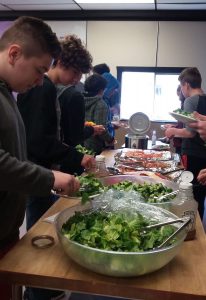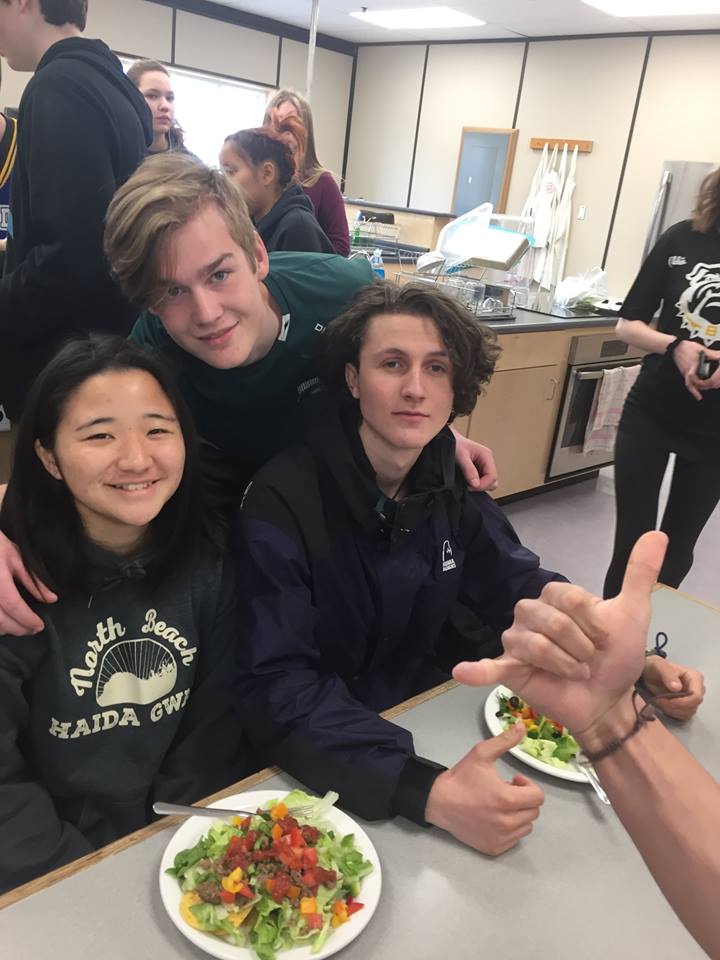Gudangaay Tlaats’gaa Naay Secondary School, Masset BC
2017-2018 (Year 2)
I remember the first salad bar many years ago at Gudangaay Tlaats’gaa Naay (GTNS), a high school on the north end of Haida Gwaii. When faced with the salad bar over flowing fruit and vegetables, students filled their plates with ranch salad dressing and bacon bits. Eight years later the story is so different. Under the leadership of principal Bernadette Marie, the school food culture has dramatically changed. GTNS moved from “grab and go” meals offered in the hall ways to serving home cooked hot lunches 5 days/week that include local and traditional food. Dan Schulbeck, a science teacher, supports the learning by creating opportunities for students to prepared soil, plant seeds, weed gardens and harvest food. Dan also facilitated a number of land based fieldtrips including deer hunting, fishing, clam digging and harvesting on the land, activities that connected students directly to the abundance of food that Haida Gwaii has to offer.
The school culture of eating together grew after the kitchen was renovated to upgrade the 8 station teaching kitchen. The new kitchen was then used for a hands on learning home economics course led by Zoe Sikora. Students who are in the course prepare hot lunches for the school five days per week. Students cooking for their peers, serving local salmon, venison, clams and local greens, made the difference in the cafeteria, now full of students eating together enjoying the fruits of their classmate’s labour. Over this year alone, the school purchased over 60 lbs of local berries, 176 lbs of local vegetables from farms and 175 lbs of local protein to serve in hot lunches. They also received hundreds of pounds of donated venison, fish and beef from a variety of sources.
Since January 2018, the school hosted over 10 salad bars that included 3 or more vegetables. Local food work that supports these salad bars is happening beyond the cafeteria. Since April the school’s grow towers and greenhouse has been producing 8-9 lbs of greens for the school every week. “The new grow towers (purchased with F2C grant funds) took 8 weeks from seed to harvest and then produced a crop every 2 weeks” states Dan. “The students engage with them daily in the library, cafeteria and science room.” In Dan’s gardening class this year, he facilitated over 32 hands on gardening activities, over 6 working days on compost maintenance, 4 food related field trips and 3 helping elder’s stories. In November 2017 the Local Food 2 School program hosted a 5th learning circle that connected schools, harvesters and cooks from all island. It was during the winter learning circle that a connection was made between an Elder, Margaret Edgars, Mary-Lynn Hunt, a farmer and Dan, GTN’s champion. In the following months this group teamed up to revitalize Margaret’s back yard garden. In early March, 8 students spent the morning digging up salmonberry bushes and burning brush. Another class joined in the spirit of giving back that afternoon by cutting and delivering a cord of wood to Stan Hansen, who over the years has donated his local fish and beef to the school. A final thought from a students reflective writing exercise that captures the spirit of all this good work;
“While ‘lending a hand’ to Nonni Margaret, I was hit by sudden nostalgia. I recalled helping my dad with his garden … pulling weeds. I at first dreaded the thought of giving someone free labour but then while I started pulling roots, I thought that it wasn’t a bad thing to help someone else out.” –GTNS grade 8 student
2016-2017 (Year 1)
 I remember the first attempts to engage students in Farm to School at George M Dawson Secondary in Masset, BC. In 2010, the school bought fancy salad bar equipment that cost hundreds of dollars. A red seal chef, who was teaching 5 other students in the culinary arts program in nearby Old Masset, created the foods for the salad bar. I remember the day I went to the school expecting to take photos of kids with plates full of vegetables eating variety of foods. Yet,this is not what I found. I saw a salad bar full of choices that had been barely touched and kids with plates full of ranch dressing and bacon bits! So what has changed 7 years later? So much!
I remember the first attempts to engage students in Farm to School at George M Dawson Secondary in Masset, BC. In 2010, the school bought fancy salad bar equipment that cost hundreds of dollars. A red seal chef, who was teaching 5 other students in the culinary arts program in nearby Old Masset, created the foods for the salad bar. I remember the day I went to the school expecting to take photos of kids with plates full of vegetables eating variety of foods. Yet,this is not what I found. I saw a salad bar full of choices that had been barely touched and kids with plates full of ranch dressing and bacon bits! So what has changed 7 years later? So much!
Over the past 7 years there has been an island wide movement to get more local and traditional foods onto the plates of students. As the hot meals move towards more local seafood, venison roasts, local veggies; students are also leaving the classroom and getting into the garden, getting out to the land to harvest food. These two parallel strategies; 1) getting local ingredients into the meal programs and 2) getting students connected to their food support each other and years of dedicated work by many passionate people have contributed to a different scene at Gudangaay Tlaats’gaa Naay. This year on Salad Bar days, students do have plates full of veggies and fish or venison. Youth are sitting together, eating together, and enjoying a variety of new foods – items that have been served to them day in and day out over the last 3 years with increasing consistency, with more local ingredients, and more often.
What was central to this shift in culture? In 2014 a group of dedicated and invested people came together in a Learning Circle format to create a common vision and tangible goals around local food in schools. These island citizens, teachers, principals, youth, harvesters, farmers, elders; cooks spent an entire day together creating this common theme. Since the first Local Foods to School Learning Circle and the creation of a dedicated position to coordinate local food systems on island, everything has ramped up. Funds have been secured to ensure every school has access to a community garden or greenhouse. Students are regularly getting out on the land and learning about where their food comes from, harvesting food and processing back in school kitchens and finally eating it. More local food is being incorporated into meals at all schools.
At the same time the high school has been renamed by Haida elders and honours Haida Traditional language. The culinary arts program increases the number of local first nation cooks in their kitchen. Helen Davis and Elliot Jones managing the industrial kitchen, preparing over 800 meals /week for students K-12. Passionate school staff like Charlotte Marks, Daniel Schulbeck and Principal Bernadette Marie is making food a priority in the school. The goal is not only to feed hungry children, but also to value and honour the richness the island has to offer.
What I have learned over the last 7 years is that it takes time to change food culture in a school or institution. It takes passion and dedication from community members to keep serving local food, to keep getting kids in the garden and out on the land. And if you continue to do this work, the youth embrace healthy local food as familiar and nourishing.






[…] In Masset, British Columbia, Gudangaay Tlaats’gaa Naay Secondary School (GTNS)’s salad bar story shares how their school food culture changed dramatically thanks to a Learning Circle and a supportive principal. The school, located on the north end of Haida Gwaii, moved from “grab and go” hallway meals to home-cooked hot lunches 5 days a week that include local and traditional foods. Students are also preparing soil, planting seeds, weeding gardens, and harvesting food. A science teacher has facilitated a number of land-based field trips, which include deer hunting, fishing, clam digging and harvesting on the land. Back in 2016, GTNS shared with us: “Over the past 7 years there has been an island wide movement to get more local and traditional foods onto the plates of students. As the hot meals move towards more local seafood, venison roasts, local veggies; students are also leaving the classroom and getting into the garden, getting out to the land to harvest food.” Read more from GTNS here. […]